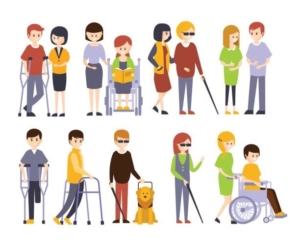 In today’s diverse workplaces, fostering an environment of mindful safety is essential. This not only ensures compliance with legal standards but also cultivates a culture of respect and inclusivity. For colleagues with physical disabilities, small considerate actions can significantly impact their daily experience and overall well-being at work.
In today’s diverse workplaces, fostering an environment of mindful safety is essential. This not only ensures compliance with legal standards but also cultivates a culture of respect and inclusivity. For colleagues with physical disabilities, small considerate actions can significantly impact their daily experience and overall well-being at work.
One simple yet impactful practice is the mindful placement of furniture. Consistently pushing chairs back under desks or tables after use can prevent tripping hazards. This is particularly important for colleagues who are blind or visually impaired, as unexpected obstacles can pose significant risks. By making a habit of keeping pathways clear, we contribute to a safer environment where everyone can navigate with confidence.
Clutter-free walkways are critical for all, but especially for those with mobility impairments. Items left on the floor, such as boxes, cables, or personal belongings, can impede mobility for individuals using wheelchairs, crutches, or prosthetic limbs. Ensuring that hallways and communal areas are free of obstacles demonstrates a collective commitment to accessibility and consideration. Additionally, arranging furniture to allow ample space for maneuvering can make a significant difference for colleagues who rely on mobility aids.
Communication plays a vital role in supporting colleagues with physical disabilities. For those who are deaf or hard of hearing, facing them directly when speaking and maintaining eye contact can facilitate better understanding through lip-reading and facial expressions. Using clear enunciation without exaggerated speech, and minimizing background noise, shows mindfulness in communication. Providing written summaries of meetings or important discussions can also be immensely helpful.
When interacting with someone who is visually impaired, announcing your presence and identifying yourself can make conversations more comfortable. Offering assistance—but always asking first—shows respect for their autonomy while acknowledging any potential needs. For example, you might say, “Hi, it’s [Your Name]. Would you like assistance finding the conference room?” This approach is considerate without being presumptuous.
Moreover, incorporating assistive technologies and accessible design in workplace practices benefits everyone. Ensuring documents are compatible with screen readers, providing captions or sign language interpretation for video presentations, and selecting meeting locations that are accessible to all are steps that promote inclusivity. Adjustable workstations can accommodate those with mobility impairments or chronic pain, allowing them to modify their workspace to their comfort level. Training sessions on disability awareness can further educate staff about best practices and encourage empathetic interactions.
Emergency procedures should also account for the needs of employees with physical disabilities. Establishing clear evacuation plans that include assistance protocols ensures that all team members can exit safely during an emergency. For instance, assigning “buddies” to help colleagues with mobility impairments can facilitate a quicker and safer evacuation. Regular drills that involve everyone can help identify any gaps in the plan and reinforce a unified approach to safety.
Accessibility in restrooms, kitchens, and common areas is another essential aspect. Installing features like grab bars in restrooms, adjustable-height countertops, and accessible appliances can make daily tasks more manageable for individuals with physical disabilities. Ensuring that these areas are kept clean and unobstructed is part of maintaining a mindful and inclusive environment.
Ultimately, mindful safety in the workplace is about more than just adhering to regulations; it’s about fostering an environment where every employee feels valued and supported. By paying attention to the small details—like pushing in chairs, keeping areas clutter-free, and adapting communication methods—we show respect for our colleagues’ needs. Embracing a culture of mindfulness not only enhances safety but also strengthens the sense of community within the workplace. Creating a safe and inclusive work environment requires intentional actions and a commitment to mindfulness. By being aware of how our behaviors affect others, especially those with physical disabilities, we can make meaningful strides toward a workplace that is accessible and welcoming to all. Through collective effort and ongoing education, we ensure that safety and inclusivity remain at the forefront of our organizational values. If you would like assistance in making your workplace more inclusive for individuals with physical disabilities and impairments, we would love to help! Reach out to us at 518-465-3813 to schedule an appointment with our Masters Level EAP Clinicians.
By: Denelle Abel, LMHC, EAP Clinical Supervisor/Clinician
